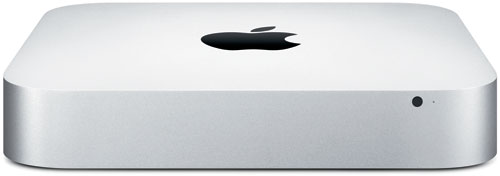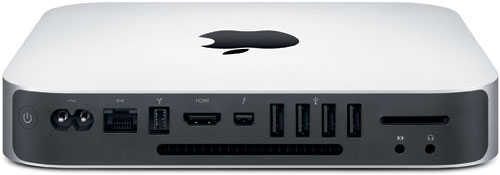Hosted by site sponsor WebMate.
Aluminum "Unibody" Mac mini Q&A
Update Published November 11, 2014
All Mac Q&As >> Aluminum Mac mini Q&A (Home)
To be notified of new Q&As, sign up for EveryMac.com's bimonthly email list.
What are all the differences between the "Late 2012" Aluminum "Unibody" Mac mini models?
Please note that the "Late 2012" Mac mini models have been discontinued. However, this Q&A is up-to-date and can be quite helpful for anyone buying or selling one of these systems on the used market.
With even a detailed hands-on evaluation of the "Late 2012" Aluminum Mac mini models -- the Mac mini "Core i5" 2.5, "Core i7" 2.3, "Core i7" 2.6, "Core i7" 2.3 (Server), and "Core i7" 2.6 (Server) -- which share the same "Unibody" case crafted from a single block of aluminum, one would not find any obvious differences between them.
Nevertheless, there are important differences in hardware and software -- as well as identification differences -- that merit evaluation.

Photo Credit: Apple, Inc.
External & Connectivity Differences (Or, the Lack Thereof)
All five of the "Late 2012" configurations use the same small "cuboid" aluminum case -- just 7.7 inches across and deep and 1.4 inches tall -- and have the same "spin off" black plastic base on the bottom that can be removed quickly to access the RAM slots. None have an internal optical drive (although site sponsor Other World Computing has a variety of Apple and third-party external optical drive options
).
Photo Credit: Apple, Inc.
All five systems have identical connectivity, too. Connectivity includes 802.11n Wi-Fi (backwards compatible with 802.11a, b, and g), Bluetooth 4.0, four USB 3.0 ports, a single Firewire "800" port, an HDMI port, a Thunderbolt port (capable of supporting an external display at 2560x1600 while passing an audio signal or alternately supporting Thunderbolt-compatible peripherals), a single "audio line in (digital/analog)" minijack, a single "audio line out/headphone (digital/analog)" minijack, a 10/100/1000Base-T Gigabit Ethernet port, and an SDXC-capable SD card slot. All support IR for a remote, too.
Identification Differences
Externally, the "Late 2012" Mac mini line shares its single A1347 Model Number with earlier aluminum-clad Mac mini models, and as a result, it is not convenient to use for identification. However, these configurations do share a unique 2570 EMC Number -- visible upon removing the bottom "spin off" panel (on the righthand side with the ports facing you) -- and EveryMac.com has carefully hand-documented this detail accordingly.
In software, the entry-level Core i5-powered configuration can be identified by the Macmini6,1 Model Identifier whereas the all of the Core i7-powered configurations -- including the Server options -- can be identified by the shared Macmini6,2 Model Identifier.
EveryMac.com's Ultimate Mac Lookup feature also can identify the "Late 2012" Mac mini models by their Serial Numbers.
Internal Differences
Although there are some similarities internally -- all use Intel "Ivy Bridge" processors of differing types and speeds with a 5 GT/s "Direct Media Interface," all have "integrated" Intel HD Graphics 4000 that share memory with the system, and all support 1600 MHz PC3-12800 DDR3L SO-DIMMs and two 6 Gb/s Serial ATA hard drives, for example -- there are significant differences as well.
The most significant internal difference is that the entry-level Mac mini "Core i5" 2.5 (Late 2012) has a dual core Core i5 processor, whereas all of the other configurations -- the Mac mini "Core i7" 2.3, "Core i7" 2.6, "Core i7" 2.3 (Server), and "Core i7" 2.6 (Server) -- have quad core Core i7 processors that provide vastly superior performance. The Core i7-powered configurations also have larger hard drive(s) by default and the non-server configurations additionally can be configured with a "Fusion Drive" that combines a 128 GB SSD and a 1 TB hard drive with software that "automatically and dynamically moves frequently used files to flash for quicker access."
As one would expect, the server configurations also differ as they have dual hard drives by default and OS X Server software for OS X 10.8 "Mountain Lion" is pre-installed. The "regular" models can be equipped with server software after purchase if desired.
Comparison Chart
Configuration differences are summarized below for the default options along with processor, identifier, and price differences for both the standard and custom configuration options:
 i5 2.5 |
 i7 2.3 |
 i7 2.3 (Server) |
|
|---|---|---|---|
| Processor Speed: | 2.5 GHz | 2.3 GHz* | 2.3 GHz* |
| Processor Type: | Core i5 (3210M) | Core i7 (3615QM)* | Core i7 (3615QM)* |
| Processor Cores: | 2 | 4 | 4 |
| L3 Cache: | 3 MB | 6 MB | 6 MB |
| Std. RAM: | 4 GB | 4 GB | 4 GB |
| Graphics Processor: | HD Graphics 4000 | HD Graphics 4000 | HD Graphics 4000 |
| VRAM Type: | Integrated | Integrated | Integrated |
| Std. VRAM: | 512 MB | 512 MB | 512 MB |
| Std. Hard Drive: | 500 GB | 1 TB | 1 TB x2 |
| Fusion Drive Option: | No | Yes | No |
| OS X Server: | No | No | Yes |
| Order Number: | MD387LL/A | MD388LL/A | MD389LL/A |
| Model Identifier: | Macmini6,1 | Macmini6,2 | Macmini6,2 |
| Intro Price: | US$599 | US$799* | US$999* |
* These systems also were available via custom configuration with a 2.6 GHz "Core i7" (I7-3720QM) processor for an extra US$100. As requested by readers, EveryMac.com additionally has documented these custom regular and server configurations as their own models.
Comparison Summary
Among the "Late 2012" Mac mini models, the entry-level Mac mini "Core i5" 2.5 model is the least expensive and the obvious choice for one on a budget, although all three now are relatively inexpensive on the used market compared to newer models.
If performance is more important than price -- and you're not turned off by the relatively slow "integrated graphics" in all of the "Late 2012" Mac mini models -- the high-end stock Mac mini "Core i7" 2.3 or custom-configured Mac mini "Core i7" 2.6 with much faster quad core processors, are a better choice than the Core i5-powered entry-level model. Naturally, for demanding 3D use -- whether for gaming or graphics work -- integrated graphics never are ideal, and a Mac with faster dedicated graphics would be preferable.
For server use, the "Late 2012" Mac mini Server configurations -- the standard Mac mini "Core i7" 2.3 (Server) or custom-configured Mac mini "Core i7" 2.6 (Server) are small, energy efficient, and make setting up a server simple.
Mac mini Purchase Options
There are no shortage of places to purchase a new or used Mac mini. However, buying from a good company with an extensive track record in the Mac market will provide the best experience and save you money and time, too.
In the US, site sponsor Other World Computing sells used and refurb Mac mini models at bargain prices with free shipping, as well. Finally, if you need to sell a Mac mini, A+ BBB-rated Cash for Your Mac will buy your older Mac mini with an instant quote and prompt payment.
In the UK, site sponsor Hoxton Macs sells used Mac mini models with a one-year warranty and free next day delivery throughout the UK. Delivery across Europe also is available starting at just £9.99 for two-day delivery to France and Germany.
Please also refer to EveryMac.com's Ultimate Mac Comparison feature to dynamically compare any Mac mini model to any other Mac.
Permalink | Report an Error/Typo | Sign Up for Site Update Notices
Suggest a New Q&A | Sign Up for Bimonthly Site Update Notices
<< Aluminum "Unibody" Mac mini Q&A (Main) | All Mac Q&As
Established in 1996, EveryMac.com has been created by experts with decades of experience with Apple hardware. EveryMac.com includes, and always has included, original research incorporating detailed, hands-on inspection of packaging, computers, and devices as well as extensive real-world use. All information is provided in good faith, but no website or person is perfect. Accordingly, EveryMac.com is provided "as is" without warranty of any kind whatsoever. EveryMac.com, and the authors thereof, shall not be held responsible or liable, under any circumstances, for any damages resulting from the use or inability to use the information within. For complete disclaimer and copyright information please read and understand the Terms of Use and the Privacy Policy before using EveryMac.com. Copying, scraping, or use of any content without expressed permission is not allowed, although links to any page are welcomed and appreciated.
